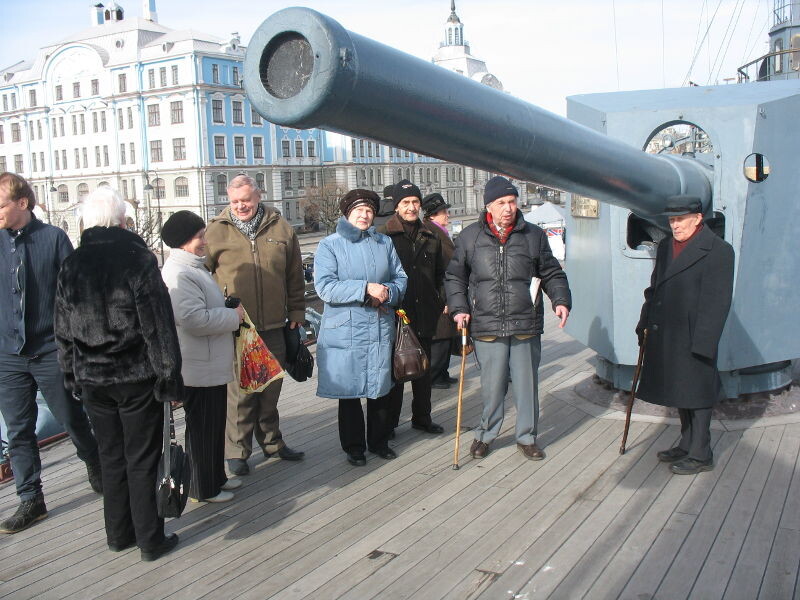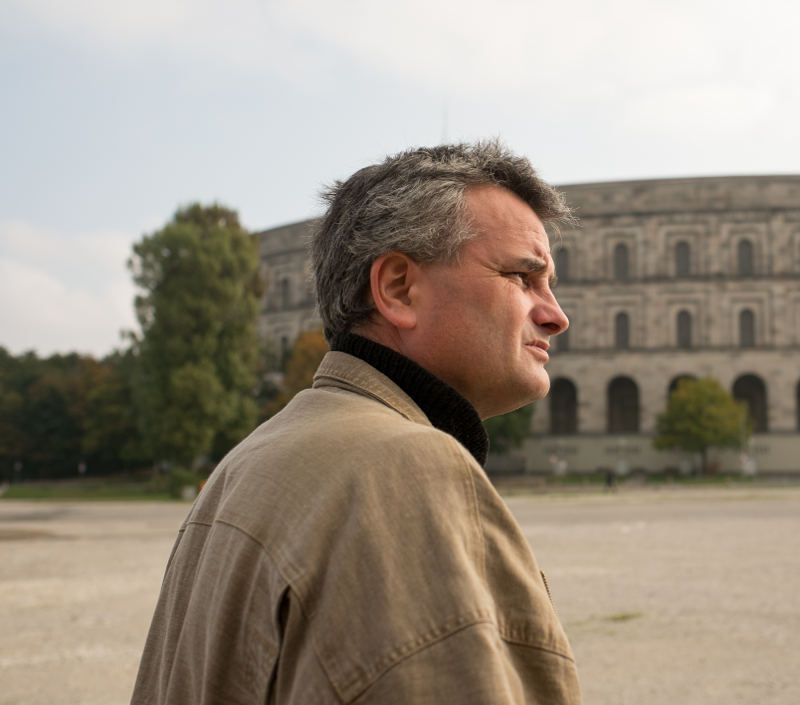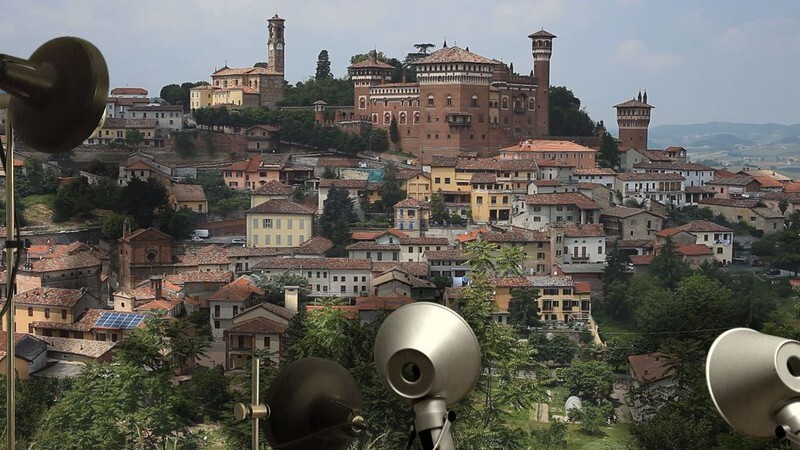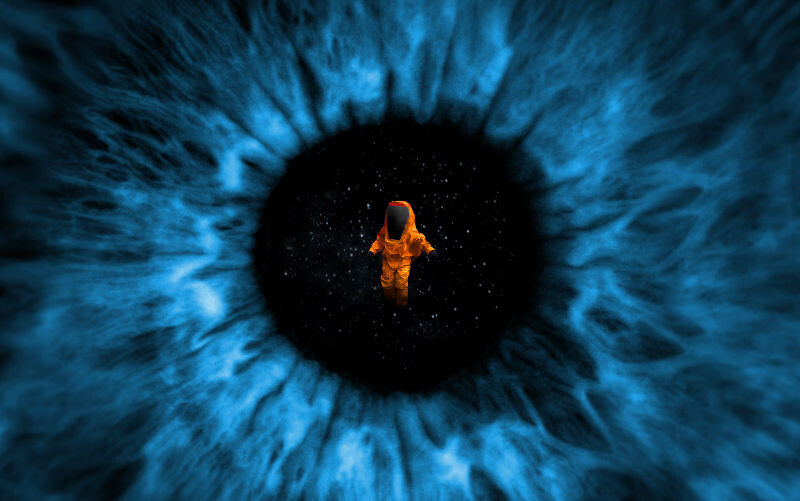Face to Face with History
The film deliberately challenges the ingrained perceptions of the captured monuments through an in-depth reflection of their possible meanings and implications, the playfulness and the personal approach of the protagonists who thus become the film’s co-authors. In addition to other issues, the interview discusses the question of whether excursions can be considered some sort of performances and what constitutes the political significance of situational etudes.
Your film called Excursion or the History of Now offers a lot of creative space to social actors, especially tour guides. What was your approach to them and the role they played?
Tour guides are essentially performers: they are trying to capture the attention of the participants of the excursions using psycho-physical gestures. Aside from the performance aspect, I also wanted to emphasise their role as translators – every guide also acts as a translator from the past into the present. At the same time, my aim was to make sure that the film’s form matches the content, that is – not to speak about translations, but to become one, to serve as a translation between the past and the present, between places and people, between us.
Have you come across any problems when working with the guides? For example, the excursion to Aurora is much less playful and interactive than others.
The reason is that I wasn’t actually present to the shooting on the ship. After my arrival to St Petersburg, my assistant informed me that foreign filmmakers have been banned from Aurora due to some incident with one Australian TV broadcaster. The Crimean crisis might have played a role in the incident too. So I directed the scene from a restaurant called Aurora, one hundred meters away. The cameramen couldn’t utter a word on the ship because they pretended they were a Russian film crew. Fortunately, they knew exactly what to do because they had experience from our previous work and the assistant followed most of my instructions. When watching the footage, I realised that perhaps the actors wouldn’t have been so open had they heard the crew speaking Czech. They felt they were among their own people and could focus on the things of a divine, state, national, historical, imperial nature in a more intimate and essential way. As I see it, Russians are the world champions of metaphysical insight. This is what I find astounding and scary at the same time when it comes to Russians. The whole is more important than an individual – unlike in the west, where it’s the other way round.

Weren’t you tempted to mention these difficulties in the film?
We shot a scene in the Aurora restaurant where I was explaining that I wasn’t allowed to enter Aurora. But during editing, most of my colleagues were persuading me to leave it out. They explained that it would have just been an isolated utterance that wouldn’t have played any further role in the film. In the end, I admitted that such a scene would actually be misleading for the viewers. I am not the film’s protagonist and the behaviour of the people on Aurora is much more important than the effect of the censored version would have been. I’m afraid that the scenes from Russia would lose its diversity and specifics in which the power-related and authoritarian symptom blends with intimate spirituality.
Deconstruction of the director's position of power
In some other scenes, you actually accentuate that you are present with your camera – you go in front of the camera, stage the scenes with the protagonists, ask questions. But you don’t reflect on your experience own from the visits to the monuments. Why?
Although I sometimes appear in front of the camera or ask questions in my films, I never explicitly say what I personally think. I am the initiator, co-player, and a chameleon, who becomes a part of the events and at that moment, my opinion is inherent to the situation as it is: reflected in the choice of the topics, protagonists, places, and the method of shooting. Egos become a part of the ego of the context. Nearly fifty years ago, Foucault succinctly put it in his lecture on the death of the author: it is not a particular person, but always a certain form of a discourse speaking.
Don’t you think that you expose yourself to risky or transformative experiences in the film just like the protagonists?
One of the reasons why I appear in my films is to emphasise that I am also a protagonist, and that the protagonists are also the film’s authors. In this way, I’m trying to deconstruct the power position of the director as the centre of gravity behind the camera controlling the film’s time and space. In some cases, the protagonists are more in control over the situation when they act in some striking or expressive way, and at that moment the director becomes an actor. The principle of interaction implies the indivisibility of experience in the sense that some of us take bigger and some take smaller risks. Situations that are not staged pose a potential threat for all those involved because as standard, the selected places are associated with solemnity and silence, and you would not expect, for example, that the mother of a tour guide will play hopscotch in a former Nazi congress hall.
The film and your comments imply that Excursion is a collective work. Do you think that that’s compatible with the today so popular category of “authorial” or “auteur” documentary film?
With the exception of František of His Own Kind (2014), where my subversive motive was to adapt the film to professional standards, I’ve never used the description “A film by Jan Gogola jr.”. I’ve always perceived my, or our films, as collective works. I made a film about Antonín Panenka, Panenka Against the Rest of the World (2001), whose script actually revolves around the goals scored long ago by soccer player Panenka – who is then the film’s real author? The term “authorial” or “auteur” is supposed to emphasise the film’s specific perspective as compared with standard documentaries that have the ambition to record reality in a way similar to colouring books. It’s an attempt to find a term replacing the objectivising term “documentary”, but it’s problematic in that each work has an author, or a co-author. It is a vague way of expressing that you distance yourself from the term “documentary” which you can’t do anything about, apart from replacing it with standard genre-specific terminology or neologism.
Being a sort of a film performance, your Excursion attempts to challenge and transform the meanings traditionally attached to symbolical places. Can conflict-free and, in the strict sense of the word, apolitical games lead the participants (and preferably also the viewers) to review their own prejudices and clichés?
To me, the very fact that you can view specific places – historical places – in a unique way is highly political and conflicting because it problematizes the definiteness of pro-regime or anti-regime interpretations between which you are somehow forced to choose. The question is, to what extent these prejudices and clichés stem from these explicitly political films that are based on a-priori and ingrained attitudes. Isn’t European crisis actually the result of a constant competition of established discourses, digging of trenches and the absence of examples of political imagination – which would introduce a new language, symbols and signs?
Colourful nation
Does playful displacement of facts from their usual context automatically lead to the disruption of the traditional view of the monuments?
No. In its essence, automatism cannot make anyone free. The fact that the film shows two women playing badminton over the Berlin wall does not mean that you should go and do the same. However, it can help you realise the relative character of history, its interpretation and its monuments. And most of all, when you talk to people who see the wall as a death zone, a tombstone, an artefact, a memory, a workplace, a network, a musical instrument, you are relativizing the monopoly of a certain interpretation, at the same time realising that it is no longer a dividing, but a connecting element. We deal with it each in our own different way, but we face it together. This is what we are lacking in Europe, and so we are building a wall, not as a screen for our mental projection, but as a barrier, not between refugees and Europeans, but between Europeans themselves. Europeans try to mentally escape from themselves, it’s a refugee crisis inconceivably worse than the visible intercontinental one, and we are lacking playful, metaphorical and imaginative situations which would translate our diversity into the form of a fundamental unity. What holds Europe together is the euro currency, institutions and geopolitical interests, not ethos.
And what if the individual experiences and stories of the protagonists don’t challenge the ingrained meanings? Many testimonies by Russian veterans on the Aurora are in line with the official version perpetuated by the regime, and one protagonist in Nuremberg even openly admits to being fascinated by Nazi art.
The veterans on Aurora may be performers acting in line with the national ideology, but on the other hand, our excursion is not a standard one in that it combines the intimate and the public aspect. Revolution means toppling of the establishment but also loving a woman – they are capable of loving their state as much as they love a person. Their position is actually impersonally personal. And the fascinated look at the ceiling of the Golden Hall in Nuremberg is a part of the transformation of the space into a children’s room. Something that wasn’t supposed to be happening is going on at a well-known historical place. This perspective represents something similar to a redecoration. And such a place doesn’t have to be associated with Nazism because then it would be usurped by the Nazi ideology for good.
The role of monuments is currently widely discussed – some of them are allegedly reinforcing the feeling of guilt, others perpetuate xenophobia, or have been deformed by national myths. Can you think of any monument that would directly suggest a creative and liberating interpretation of the past?
There’s one invisible monument – Kaplický’s National Library – living in the minds of many of us. Since the rejection of the project – being a national library, or a national institution – it has served as a monument and testimony to the fact that the Czech identity can also have an organic, fluid, neo-Baroque form, and not necessarily be based on the predominant functionalist principle that has affected our architecture all the way from the First Republic through communist blocks of flats to the present day. Its colourful design can also be seen as an impulse to realising that Czechs too, can be a colourful nation. The project of a library on Letná plays the role of a liberating monument whose elusive nature opens up further possibilities. And not only in functional terms – for example that the state should function as a business – but it’s a place, albeit invisible, where you can go and read books, admire Prague’s skyline and look at the world. Hence, it serves as an example of the helplessness of the mighty and a proof that architectural curves can also be politically charged.
Translated by Viktor Heumann.
|
|
Jan Gogola ml. (1971) is a Czech director, dramaturge, screenwriter and a lecturer. In his mostly performative and stylised films, he addresses, among others, the ordinariness and transformations of everyday life. As a director, he made films such as Non-stop (1999), Situation of the Street, or the Czech Sea in Eighteen Tidal Waves (2003), I Love My Boring Life (2006), the winner of the Czech Joy competition at the Jihlava IDFF 2009 and Mythmaking (2013). He is also renowned as a dramaturge, collaborating on approx. 200 film titles, such as Czech Dream (2004) by Vít Klusák and Filip Remunda, Katka (2010) by Helena Třeštíková, and Velvet Terrorists (2013) by Peter Kerekes. |





